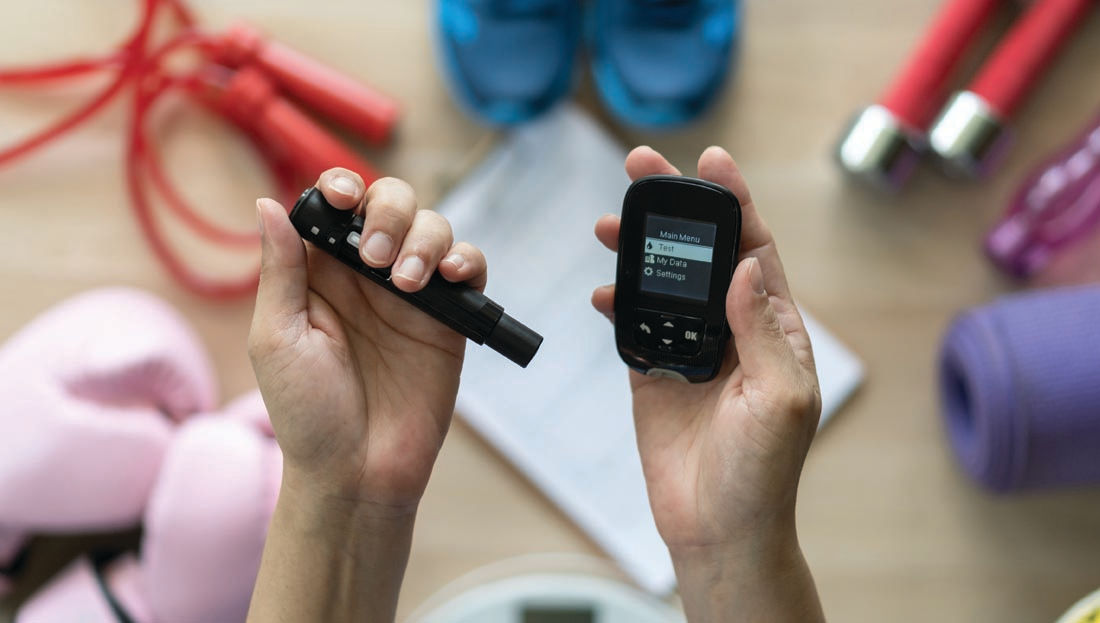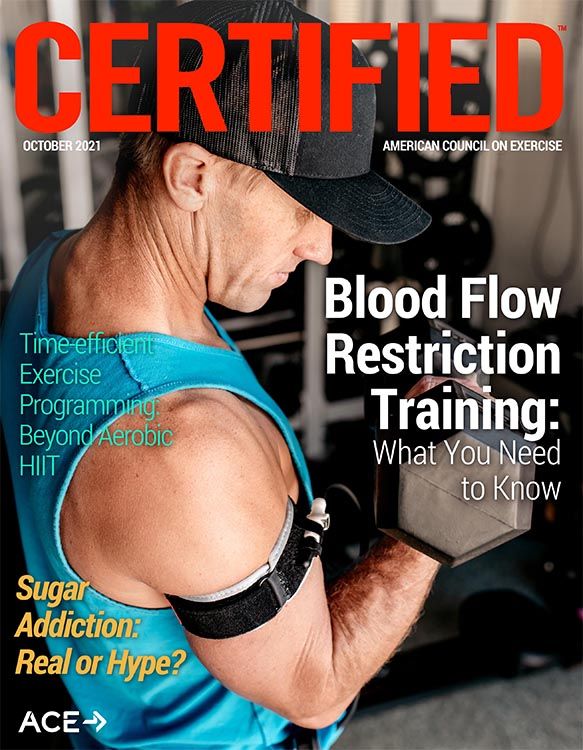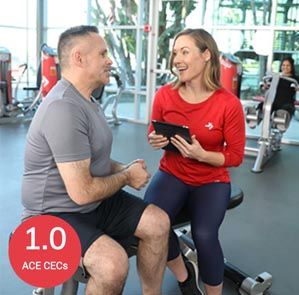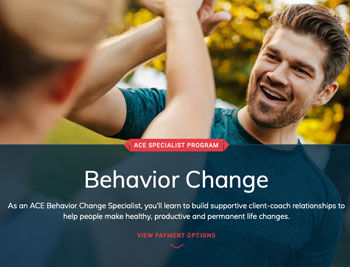
Many people with type 1 diabetes do not exercise or achieve a recommended amount of exercise for fear of experiencing hypoglycemia (low blood sugar) or hyperglycemia (elevated blood sugar), which can sometimes occur following exercise. As a health and exercise professional, you can support your clients who have type 1 diabetes by helping them gain confidence in their ability to manage blood glucose levels during exercise. You can also help them implement the recommendations they receive from their healthcare providers.
Understanding Type 1 Diabetes
Approximately 5 to 10% of all people with diabetes have type 1, which is a chronic condition in which the pancreas does not make insulin or does not make enough insulin. Insulin is needed to transport glucose from the blood (blood sugar) into cells where it can be converted to energy. Without insulin, sugar builds up in the bloodstream, which, over time, can cause serious complications, including heart disease, neuropathy and kidney damage. People with type 1 diabetes must check their blood sugar levels and add insulin to their bodies exogenously using injections, a pump, or inhalation to keep blood sugar levels in a healthy range. For reference, according to the Centers for Disease Control and Prevention, the typical desired blood glucose range is:
- Before a meal: 80 to 130 mg/dL
- Two hours after the start of a meal: Less than 180 mg/dL
However, targets should be tailored to each individual by a healthcare provider, depending on age and additional health issues.
Physical activity and exercise are especially important for people who have either type of diabetes, as physical activity can help to maintain blood glucose levels and prevent long-term complications related to the condition. While there are some inherent risks with exercise, the benefits largely outweigh the risks for people with type 1 diabetes if implemented with the oversight of the care team.
It is important to ensure that your client has approval from their physician or care team prior to working with you. The care team may include a physician, registered dietician or diabetes educator. As a health and exercise professional, it is outside of your scope of practice to provide nutrition guidance or advice to people with type 1 diabetes. These individuals require medical oversight when it comes to nutrition guidance, and medical nutritional therapy (MNT) can be provided by a registered dietitian.
Exercise Guidelines for Individuals With Type 1 Diabetes
Earlier this year, the American Diabetes Association published the following exercise guidelines for most adults with type 1 diabetes:
- Perform a minimum of 150 minutes of moderate-to- vigorous intensity aerobic activity per week spread over at least three days, with no more than two consecutive days without activity
- Two to three sessions of resistance training per week (on nonconsecutive days)
- Two to three sessions of flexibility and balance training for older adults with diabetes
While these basic guidelines for people with diabetes mirror the current Physical Activity Guidelines for Americans, the type, duration and intensity of the workout can influence glucose levels in different ways, and exercise should be recommended accordingly. For example, hyperglycemia is known to occur after bouts of strenuous, high-intensity workouts, especially when doing a fasted workout, whereas hypoglycemia may be triggered by prolonged exercise.
Common Signs and Symptoms of Hypo- and Hyperglycemia
While signs and symptoms vary from person to person, the American Diabetes Association has identified the following common signs and symptoms of both hypoglycemia (low blood glucose) and hyperglycemia (high blood glucose).
Common signs and symptoms of hypoglycemia:
- Feeling shaky
- Being nervous or anxious
- Sweating, chills and clamminess
- Irritability or impatience
- Confusion
- Fast heartbeat
- Feeling lightheaded or dizzy
- Hunger
- Nausea
- Color draining from the skin (pallor)
- Feeling sleepy
- Feeling weak or having no energy
- Blurred/impaired vision
- Tingling or numbness in the lips, tongue or cheeks
- Headaches
- Coordination problems, clumsiness
- Nightmares or crying out during sleep
- Seizures
Common symptoms of hyperglycemia:
- High blood sugar
- High levels of sugar in the urine
- Frequent urination
- Increased thirst
Helping Clients While Staying Within Your Scope of Practice
As a health and exercise professional, you can support your clients with type 1 diabetes by helping them understand and adhere to the nutrition and exercise recommendations provided by their healthcare team, explains Dr. Natalie Muth, a physician and registered dietitian. “For example, a physician might provide an exercise prescription or blood glucose monitoring instructions during physical activity. A health and exercise professional can help the client safely and effectively implement the plan.”
Additionally, the client’s care team may prescribe specific guidelines on dosing insulin before workouts, as well as carbohydrate recommendations for pre- and post-workout nutrition.
Helping your clients incorporate healthy lifestyle habits that can prevent or reduce long-term complications related to type 1 diabetes is essential. These healthy habits may include slowly increasing physical activity, improving sleep and sleep hygiene, developing stress-management skills, and adhering to the nutritional habits and recommendations prescribed by the care team.
The American Diabetes Association urges caution when designing and implementing an exercise program for clients with type 1 diabetes: “…although exercise in general is associated with improvement in disease status, care needs to be taken in titrating exercise with respect to glycemic management. Each individual with type 1 diabetes has a variable glycemic response to exercise. This variability should be taken into consideration when recommending the type and duration of exercise for a given individual.”
Three Keys to Success
There are three keys to success for exercising with type 1 diabetes:
- Understanding and testing blood glucose levels before and after exercise
- Slowly increasing physical activity
- Paying close attention to the cool-down and recovery period
As such, here are some specific recommendations for how you can help your clients incorporate these three keys to success.
1. Understand and test blood glucose levels before and after exercise. The client should test blood glucose levels before and after working out; for longer workouts, check glucose levels every 30 minutes. In their consensus statement on exercise management in type 1 diabetes, Riddel et al. recommend a starting blood glucose range of approximately 126 to 180 mg/dL before beginning aerobic exercise. However, it is essential to discuss specific glucose target ranges with the provider.
You can support your clients by assisting them with keeping precise records of blood glucose numbers before and after exercise, insulin dosing and timing, and nutrition logs in conjunction with workout logs to determine what combination of factors helps them keep glucose in a healthy range. A client's medical providers can help to interpret this data. It generally takes some trial and error to figure out how to best combine these factors to keep blood glucose within the target range, while increasing physical activity.
2. Slowly increase physical activity. If a client has been mostly sedentary prior to working with you, adding exercise into the routine should be done very slowly and strategically, and should begin with low-impact aerobic and resistance training.
Research indicates that resistance training as well as interval training can help prevent hypoglycemia; as such, it should therefore be prioritized for people with type 1 diabetes, although each client’s care providers will provide insight based on their individual needs. Compared to aerobic exercise, resistance training tends to cause less fluctuation in blood sugar levels, and some research indicates that doing resistance exercise prior to cardiovascular exercise may be an effective method for managing blood glucose during the workout period. Additionally, compared to steady-state aerobic exercise, research suggests that interval training may make it easier to manage glucose levels during cardiorespiratory activity.
3. Pay close attention to the cool-down and recovery period. A post-workout cool-down and recovery is key to preventing big drops in blood glucose levels. Earlier this year, updated exercise and nutrition guidelines for people with type 1 diabetes were published in The Lancet, and the authors highlighted the importance of the post-recovery period. “The post-exercise recovery period presents an opportunity for maximizing training adaptation and recovery,” write the study authors, “and the clinical management of glycemia through the rest of the day and overnight.”
If glucose levels are slightly elevated at the end of the workout, a cool-down exercise period can allow blood glucose levels to come down without the need for insulin. If glucose is low or trending down at the end of a workout, a cool-down can be skipped in favor of consuming carbohydrates. Again, a client’s medical providers can provide specific glucose target ranges. Be sure a carbohydrate food (to address hypoglycemia) and insulin (to address hyperglycemia) are available after the workout (both of which should be prescribed by the client’s care team).
Finally, sleep is important for recovery in general, but for people with type 1 diabetes, sleep is especially important, as poor sleep is related to reduced insulin sensitivity. Exercise should never be recommended at the expense of sleep. Sleep hygiene practices, such as reducing screen time before bed and avoiding caffeine later in the day can help clients improve their sleep quality.
As a health and exercise professional, you play an important role in helping all your clients create and maintain healthy habits. For clients with type 1 diabetes, these habits are even more crucial, as they can help improve blood glucose management and overall well-being. If you are interested in specializing in supporting people with diabetes, be sure to review the Expand Your Knowledge sidebar below, which features online courses for learning more about how to serve this population.





 by
by 





